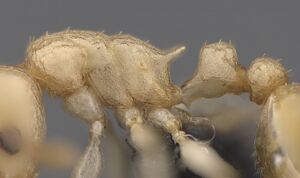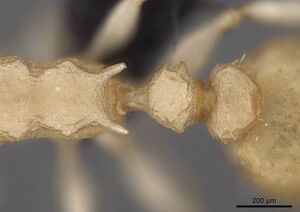Nesomyrmex devius
| Nesomyrmex devius | |
|---|---|

| |
| Scientific classification | |
| Kingdom: | Animalia |
| Phylum: | Arthropoda |
| Class: | Insecta |
| Order: | Hymenoptera |
| Family: | Formicidae |
| Subfamily: | Myrmicinae |
| Tribe: | Crematogastrini |
| Genus: | Nesomyrmex |
| Species group: | angulatus |
| Species: | N. devius |
| Binomial name | |
| Nesomyrmex devius Csösz & Fisher, 2016 | |
This species is endemic to the Malagasy region, and its distribution is restricted in the southwestern, sub-arid area of Madagascar occurring in rupicolous vegetation on granite outcrops and spiny forests.
Identification
Csősz and Fisher (2016) - A member of the angulatus species-group. Workers of N. devius differ from those of Nesomyrmex clypeatus by having no median clypeal notch and from those of Nesomyrmex angulatus by the lack of an anterolateral pronotal corner. This species can be separated from Nesomyrmex bidentatus and Nesomyrmex fragilis based on the apical spine distance ratio (SPTI/CS). This species occurs in the southern part of Madagascar syntopically with Nesomyrmex hirtellus from the N. devius complex. A simple ratio (PoOC/ SPST, see details in key) offers 92.2% success in determination between this species and N. hirtellus, but a combination of two ratios (PoOC/SPST and MW/PPH) yields a safer determination. The other two species of this complex, Nesomyrmex exiguus and Nesomyrmex gracilis do not occur syntopically with this species, as these are distributed far to the north of the distributional area of N. devius.
Keys including this Species
Distribution
Latitudinal Distribution Pattern
Latitudinal Range: -22.80222° to -25.58167°.
| North Temperate |
North Subtropical |
Tropical | South Subtropical |
South Temperate |
- Source: AntMaps
Distribution based on Regional Taxon Lists
Malagasy Region: Madagascar (type locality).
Distribution based on AntMaps
Distribution based on AntWeb specimens
Check data from AntWeb
Countries Occupied
| Number of countries occupied by this species based on AntWiki Regional Taxon Lists. In general, fewer countries occupied indicates a narrower range, while more countries indicates a more widespread species. |

|
Estimated Abundance
| Relative abundance based on number of AntMaps records per species (this species within the purple bar). Fewer records (to the left) indicates a less abundant/encountered species while more records (to the right) indicates more abundant/encountered species. |

|
Biology
Castes
Worker
Images from AntWeb
      
| |
| Paratype of Nesomyrmex devius. Worker. Specimen code casent0448825. Photographer Sandor Csosz, uploaded by California Academy of Sciences. | Owned by CAS, San Francisco, CA, USA. |
Nomenclature
The following information is derived from Barry Bolton's Online Catalogue of the Ants of the World.
- devius. Nesomyrmex devius Csösz & Fisher, 2016: 21, figs. 9A-9C (w.q.) MADAGASCAR.
Unless otherwise noted the text for the remainder of this section is reported from the publication that includes the original description.
Description
Worker
Body color: yellow; brown. Body color pattern: concolorous. Absolute cephalic size (mm): 593 [562, 620] (n D 27). Cephalic length vs. maximum width of head capsule (CL/CWb): 1.188 [1.147, 1.259]. Postocular distance vs. cephalic length (PoOc/CL): 0.394 [0.375, 0.408]. Postocular sides of cranium contour frontal view orientation: converging anteriorly; parallel. Postocular sides of cranium contour frontal view shape: straight; feebly convex; convex. Vertex contour line in frontal view shape: straight; feebly convex. Vertex sculpture: main sculpture rugose, ground sculpture areolate. Gena contour line in frontal view shape: convex. Genae contour from anterior view orientation: converging; strongly converging. Gena sculpture: rugoso-reticulate with areolate ground sculpture. Concentric carinae laterally surrounding antennal foramen: absent. Eye length vs. absolute cephalic size (EL/CS): 0.263 [0.248, 0.279]. Frontal carina distance vs. absolute cephalic size (FRS/CS): 0.415 [0.400, 0.428]. Longitudinal carinae on median region of frons: absent. Smooth median region on frons: absent. Antennomere count: 12. Scape length vs. absolute cephalic size (SL/CS): 0.632 [0.616, 0.661]. Facial area of the scape absolute setal angle: 0-15°. Median clypeal notch: absent. Ground sculpture of submedian area of clypeus: present. Median carina of clypeus: present. Lateral carinae of clypeus: present. Median anatomical line of propodeal spine angle value to Weber length in lateral view: 42-47°. Spine length vs. absolute cephalic size (SPST/CS): 0.340 [0.304, 0.356]. Minimum spine distance vs. absolute cephalic size (SPBA/CS): 0.371 [0.347, 0.402]. Apical spine distance vs. absolute cephalic size (SPTI/CS): 0.430 [0.401, 0.460]. Propodeal spine shape: straight. Anterolateral pronotal corner: absent. Metanotal depression count: present. Dorsal region of mesosoma sculpture: rugulose with areolate ground sculpture. Lateral region of pronotum sculpture: areolate ground sculpture, superimposed by dispersed rugae. Mesopleuron sculpture: areolate ground sculpture superimposed by dispersed rugulae. Metapleuron sculpture: areolate ground sculpture superimposed by dispersed rugulae. Petiole width vs. absolute cephalic size (PEW/CS): 0.447 [0.422, 0.481]. Dorsal region of petiole sculpture: ground sculpture areolate, main sculpture dispersed rugose; ground sculpture areolate, main sculpture rugoso-reticulate. Postpetiole width vs. absolute cephalic size (PPW/CS): 0.499 [0.464, 0.534]. Dorsal region of postpetiole sculpture: ground sculpture areolate, main sculpture dispersed rugose.
Type Material
Madagascar: Prov. Toliara, Mahafaly Plateau, Isantoria Riv., 6.2 km 74° ENE Itampolo, 24° 39’S, 43° 69’E, 80 m, 21-25.ii.2002, collection code: BLF5777; CASENT0448820, Fisher et al. (CASENT0448820, California Academy of Sciences). Paratypes: fifteen workers, and 6 gynes with the same label data (CASC).
Etymology
The name (devius = devious) refers to the relatively long path required to arrive at the current taxonomic situation of this species, caused by its superficial similarities to other taxa.
References
- Csosz, S. & Fisher, B.L. 2016. Taxonomic revision of the Malagasy members of the Nesomyrmex angulatus species group using the automated morphological species delineation protocol NC-PART-clustering. PeerJ 4:e1796 doi:10.7717/peerj.1796

